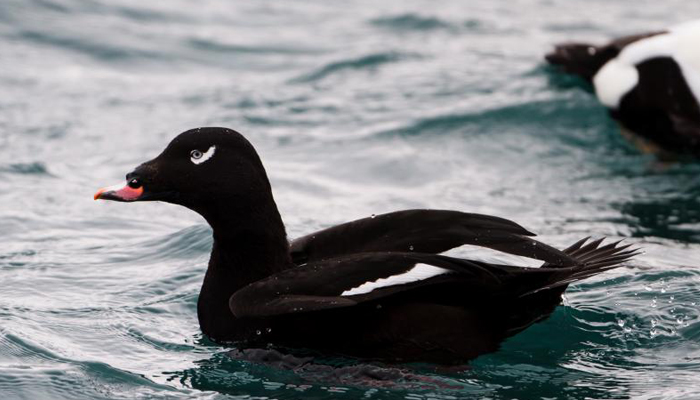
English: White-winged Scoter, Velvet Scoter
Russian: Горбоносый
турпан, Обыкновенный турпан
German: Samtente
French: Macreuse brune
Mongolian: Тольт
монхдой, Дөрт нугас
Japanese: ビロードキンクロ (Birodo-kinkuro)
Body Length: 51-58 cm
Wing span: 86-99 cm
Passage migrant
Breeding season: May-September
Egg number: 6-11
Egg colour: Non-glossy pale-creamy to buff
Brood: 1 per year
Global status: Least concern
Regional status: Least Concern
Habitat: Breeds
along coasts on salt or brackish waters (such as the Baltic Sea coasts), and on
fresh waters of mountain and tundra; often found on large lakes and rivers in
boreal coniferous forests. Breeds late, often a month later than Eider.
Migratory, movements usually along later than Eider. Migratory, movements
usually along coasts. Nests on ground, usually not far from water.
Identification:
Medium-large, stocky, rather long-bodied with thick lower neck (through upper
neck can look thin when neck is stretched). Wedge-shaped bill rather heavy.
All-dark plumage with white secondaries makes it distinctive in flight even at
long range; wings rather broad, but appearing narrower when seen against the
sky owing to the white secondaries. White in wing often, but not always,
visible as a narrow patch on swimming birds as well. Resting flocks rarely so
large and dense as those of Common Scoter. Dives without leap, wings semi-open.
Wing-flaps with head held up and bill raised, showing white secondaries.
- Adult
♂: Whole plumage black except for the white secondaries, and tiny white mark
under eye (difficult to see except at close range). Bill has pale orange-
yellow band along sides, readily visible at a distance. Rare vagrant White-winged
Scoter, which has larger white eye patch, curling up at rear, a black bill knob
and more reddish bill colour.
- Adult
♀: Sooty-brown with white secondaries; belly only slightly paler, brown-grey.
Head pattern variable: on breeding birds usually a rather large diffuse pale
loral patch, generally also a smaller but rather distinct pale patch on
ear-coverts; a few look darker with very diffuse patches only; during later
stages of breeding, wear and bleaching can cause sides of head to appear much
paler.
- Juvenile: Like adult ♀,
but belly much paler, being off-white, and facial patches generally more distinct.
Food: Molluscs, crustaceans, worms,
amphipods, insects and fishes.